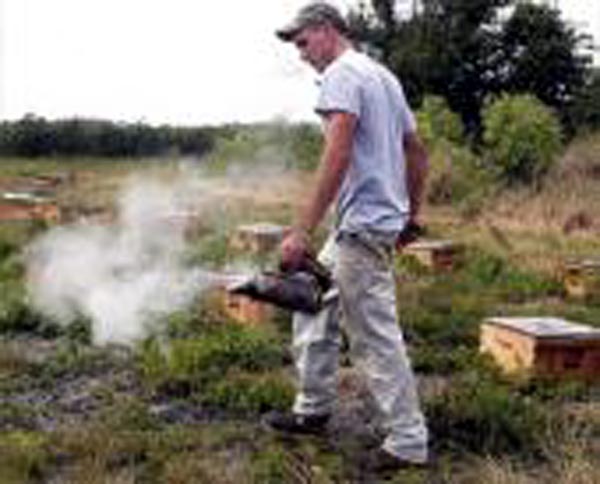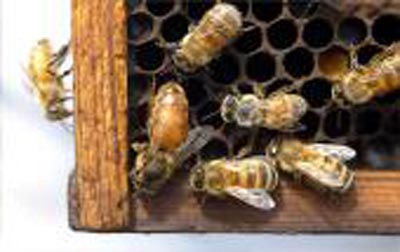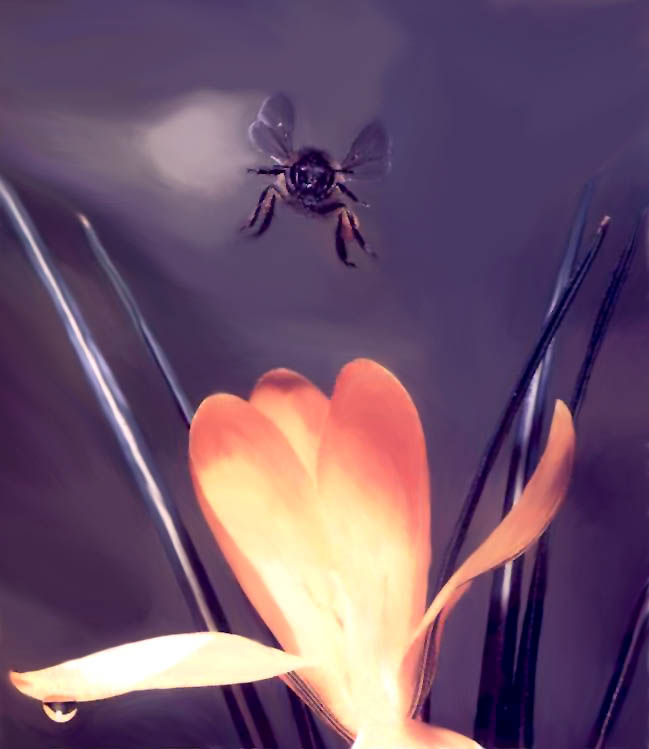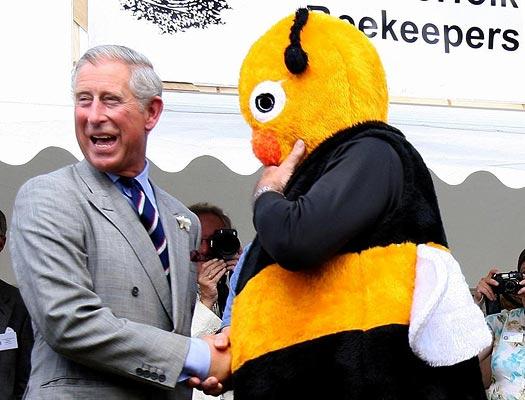About Bees
Different PerspectivesFor the million years man has lived on earth, flowers have been the glory of the green world around him. - The University of Arizona Africanized Honey Bee Education Project The Plight of the HoneybeeAs surely everyone is aware by now, honeybees are disappearing in several countries around the world. No one is sure why at this point. The problem has been dubbed "Colony Collapse Disorder" or CCD. It might be caused by a number of things - but most (all?) of the possible causes posited thus far are not new things and don't obviously explain why a sudden devastation is the result. The odd thing about CCD is that the adult bees just disappear, leaving the queen, larvae, and honey in the hive. Several live bees taken from nearly collapsed hives were massively infected with a number of viruses and fungi, but none of them were new, indicating that some sort of stress may be depressing immune response. Dr Peter Kevan, an associate professor of environmental biology at the University of Guelph in Ontario indicates that possibly the current state is the cumulative result of working bees too hard. They are trucked from job to job across the country - particularly in the US - and they are shaken, disoriented, and heavily stressed when they reach their new destination.
Source: celsias.com 15 May 2007 One unusual, unexplained symptom of CCD is that other healthy hives do not rob the now-undefended hives struck by CCD. The problem must be something that outside bees can sense. Honeybees not only produce honey, they pollinate a huge variety of crops including fruits, vegetables and nuts worth tens of billions of dollars. Their demise is, of course, a political hot potato. The Sierra Club thinks the problem might be genetically-engineered crops and their plant-produced pesticides, though they were apparently unable to offer any real proof. The Philadelphia Church of God thinks the mass death of bees is a curse brought on by mankind not living in accordance with God’s laws. One hymenopterist warns that the gaps left by the disappeared bees will be filled with "killer bees", like it or not. And these killer bees may not take too kindly to being trucked around from jobsite to jobsite. The idea that cellphones might be the cause of the bees' problems was rampant for a while, but scientific investigation thus far provides little support for adverse health effects. As bees have some magnetic particles in their stomachs, if these are used for navigation, then whatever disrupts the necessary magnetic field could be the cause (up to and including microwavwe transmitters and the Earth's magnetic field drift). Several articles posit that Albert Einstein once said that if the bees disappeared, "man would have only 4 years of life left", though a source for the quote is never cited. One lady feels the bees are being called away to heaven. Other suspects are a parasite, an unknown virus, some kind of bacteria, pesticides, or a one-two combination. Genome mapping of bees has indicated that they are somewhat lacking in genes to protect them against disease and toxins. Colonies are affected with CCD in Brazil, Britain, Canada, Croatia, Germany, Greece, Italy, Poland, Portugal, Spain, and Switzerland. Captive colonies in the United States shrank from 5.9 million in 1947 to 2.4 million in 2005. References:
Bush Beesby Michael Bush [Excerpt] Most of us beekeepers are fighting with the Varroa mites. I’m happy to say my biggest problems are things like trying to get nucs through the winter and coming up with hives that won’t hurt my back from lifting or better ways to feed the bees. This change from fighting the mites is mostly because I’ve gone to natural sized cells. In case you weren’t aware, and I wasn’t for a long time, the foundation in common usage results in much larger bees than what you would find in a natural hive. I’ve measured sections of natural worker brood comb that are 4.6mm in diameter. What most people use for worker brood is foundation that is 5.4mm in diameter. If you translate that into 3 dimensions instead of one, it produces a bee that is about half as large again as is natural. By letting the bees build natural sized cells, I have virtually eliminated my Varroa and Tracheal mite problems. One cause of this is shorter capping times by one day, and shorter post-capping times by one day. This means less Varroa get into the cells, and less Varroa reproduce in the cells. Source: bushfarms.com
Organic Bees Surviving Colony Collapse Disorder (CCD)by Craig Mackintosh Who should be surprised that the major media reports forget to tell us that the dying bees are actually hyper-bred varieties that we coax into a larger than normal body size? It sounds just like the beef industry. And, have we here a solution to the vanishing bee problem? Is it one that the CCD Working Group, or indeed, the scientific world at large, will support? Will media coverage affect government action in dealing with this issue? These are important questions to ask. It is not an uncommonly held opinion that, although this new pattern of bee colony collapse seems to have struck from out of the blue (which suggests a triggering agent), it is likely that some biological limit in the bees has been crossed. There is no shortage of evidence that we have been fast approaching this limit for some time. Source: celsias.com 15 May 2007
Bee Mites not the Problem!Dear Sir I am writing about the dilemma of our bees, in particular in regard to the publicity surrounding the Varroa mite. I wish to put it to you that the real dilemma of bees in this country (and in many other western countries) is not the mite, which like many pests has been in existence probably for centuries. The focus should move away from the mite as the pest and back on to the bee. It is the health of our bees which is sadly deteriorating to a high risk level. In nature it is a well demonstrated fact that pests attack weak life forms. So the mite attacking the bee is a symptom of sick and unhealthy bees. Not the cause, which needs to be poisoned out of existence. Why are the bees sick and unhealthy? Beekeepers at many commercial apiaries take most of the honey out of the hives each season and then feed the bees with white refined sugar as a syrup. Why? Because white sugar is cheaper than honey. But honey is the bees' natural food and medicine. White sugar diets over winter is a primary cause of unhealthy bees. Pesticides and herbicides also pose a serious health risk to bees as does the over-use of chemical fertilisers like superphosphate. These chemical potions are progressively and slowly poisoning our bee stocks and thereby weakening the bees immunity to mite attack. D W Phillips Source: Rural News 5 June 2000
I am neither a beekeeper nor a scientist, so my opinion doesn't carry the weight of authority, but I agree with Mr Phillips. When we lived in North Carolina, we fed dozens of ruby-throated hummingbirds in the spring and summer. Over the years, the numbers of hummers we had seemed to be decreasing plus occasionally the birds would act distinctly different - dizzy, almost. I suspected disease and contacted an expert. The expert told me that the hummers should never be fed sugar water, but should be fed hummingbird food with nutrients in it. He said the hummers ate sugar water to the exclusion of all else, then were laid low by disease since they got few of the basic nutrients they absolutely required. As to the funny behaviour - the sugar water sometimes fermented in the sun - the birds whose behaviour disturbed me were actually drunk. We switched to hummingbird food and had no further problems. I read on a West Virginia University website (wvu.edu) where the way to control bee mites is with "essential" oils. These include catnip, cinnamon, citronella, eucalypt, patchouli, pennyroyal, peppermint, rosemary, spearmint, tea tree, thyme or wintergreen. An oil (wintergreen is most often used in the US) is mixed with syrup and left near the hive entrance for the bee to eat. The oils kill mites within minutes after direct contact and the ingestion of the oils by the bees disrupts the mites' reproductive cycle.
Bee Killer Might not Be New21 April 2007 - Beekeepers in the US are starting to wonder if the disappearance of honeybees might have started several years ago. Deaths of bees over the past couple of years that have been blamed on mites or poor management might actually have been from the mystery ailment which is striking down millions of bees now. Some beekeepers believe they might have had this for three or four years. The mystery ailment has been called Fall Dwindle Disease by some, others are referring to it as Colony Collapse Disorder (CCD). The essential point is that in 24 US states bees are dying. Scientists at Penn State, the University of Montana and the US Department of Agriculture are among the quickly growing group of researchers and industry officials trying to solve the mystery. CCD is the latest, and most serious, die-off of honey bee colonies across the US. It is characterized by, sudden colony death with a lack of adult bees in front of the dead-outs. Honey and bee bread are usually present and there is often evidence of recent brood rearing. A recent analysis of dissected bees turned up an alarmingly high number of foreign fungi, bacteria and other organisms and weakened immune systems. Researchers are also looking into the effect pesticides might be having on bees. Among the clues being assembled by researchers:
Source: farmnews.co.nz May 2007
Bee Killer Imperils Crops in USby Susan Salisbury [Excerpt]
Mark McCoy walks among the hives with a smoker to keep bees calm, which allows beekeepers to work.
...honeybee-pollinated crops are valued at more than $15 billion a year - riding on the tiny legs of an insect. The honeybee is the major carrier of pollen for seeded fruits and just about anything that grows on a vine. Everything, in other words, from apples to zucchini. According to the American Beekeeping Federation and the US Department of Agriculture:
"If honeybees ceased to exist, 2/3 of the citrus, all of the watermelons, the blueberries, strawberries, pecans and beans would disappear," said Jerry Hayes, apiary inspection chief with the state's Division of Plant Industry. But now it's the bee itself that is disappearing. Loxahatchee beekeeper Mark McCoy is one of hundreds of beekeepers from around the country and as far away as Australia who responded to California's need for ... additional ... hives.
McCoy's father, also named Mark, is a Loxahatchee beekeeper. "The bees are the only tool we have to pollinate the trees," said Colleen Aguiar, a spokeswoman for the California Almond Board, based in Modesto. The state grows about 80% of the global almond crop, which is some 1 billion pounds of nuts a year. It takes 1.2 million hives to pollinate those groves, Aguiar said. And almonds are only the beginning of the crisis. Apple growers in Virginia normally call on their own state's beekeepers for pollination help, but not this year, said Troy Fore, executive director of the 1,200-member American Beekeeping Federation Incorporated, based in Jesup, Georgia. "Now those apple growers have also turned to Florida beekeepers to provide pollination because they have lost bees in Virginia... But Florida itself needs its bees, and some industry observers suggest it might already have given away too many. ... Those who work in the bee industry feel that the crops that don't need bees sometimes get more attention than they do. It's also admittedly difficult to evoke a passion for bees in the public mind, which often views them only as a stinging nuisance. "We have this wonderful insect that can do marvelous things. It's not warm and fuzzy," said Hayes, the state apiary inspection chief. "It's not like a manatee. You can't cuddle and pet it. Yet without it, we have a negative impact on how our society eats. Maybe we can help people not love the bee, but at least appreciate it more." Source: palmbeachpost.com photo credits Damon Higgins/The Post See also:
Bee Facts
Source: buginfo.com
German Zoologist Says Bees Not as Busy as We ThinkA German zoologist says bees aren't as busy as people are led to believe. Professor Randolf Menzel, a neurobiologist and zoologist from the Free University in Berlin, has studied bees for four decades. He said: "Bees are not particularly hardworking. Instead they sleep a lot and are lazy. They spend up to 80% of the night sleeping and even during the day they often fly to the nest where they rest their wings." But to compensate for their apparent laziness, Menzel said they were actually very intelligent. He said they were quick learners, were able to recognise various scents and had five memory phases. The researcher, who last week was awarded a prize for his work by the German Zoological Society, also said bees' learning behaviour, like many animals, was based on a reward system. "If a bee is rewarded once for something, it remembers it for a week afterwards. But if it is rewarded three times, it will remember it for its entire lifetime," said Professor Menzel. The memory capacity of the honey-making insects means they can distinguish between more than 50 different scents to find the one they want. "What is interesting is that what smells good to a bee, is also a pleasant smell for humans," said Menzel. Source: ananova.com Wednesday 16 June 2004
Homing Instinct of Bees Surprisesby Louisa Cheung Bumblebees can navigate their way home over distances of up to 13km (8 miles), a UK research team has shown. The study also found only worker bees seemed to have this homing ability. Bees pollinate flowering plants and therefore play a crucial role in food webs, but numbers of the insect in Britain have been declining recently. The team said the homing research would inform conservation strategies that sought to adapt landscapes to create optimum habitats for bees. The University of Newcastle-led group took some 100 bumblebees belonging to the common species Bombus terrestris and tagged some of them with tiny identification numbers. The bees were then dropped in different places around north-east England and left to make their way back to the nest. The scientists set up a webcam in the hive to record the homecomers. Early results show the bees will fly varying distances but some that were left at a garden centre in Heddon on the Wall in the Tyne Valley - about 13km from their nest - could get home safely. "The current scientific literature shows that bees normally forage within 5km, and this is probably correct," said Steph O'Connor, one of the researchers. "What we are showing is it is eminently possible for bumblebees to forage more than 5km from the nest." Dr Mark O'Neill said that only about 20% to 30% of the tagged insects actually completed the journey. But, explained Dr O'Neill: "Don't forget that a lot of bees got killed by predators and hitting car windscreens." It is not entirely clear how the insects navigate but their vision seems to help keep them on course and recognise landmarks. "We believe there will be a difference, because they use vision, especially the horizon edge for guidance. So a cluttered environment is liable to be more problematic and challenging to the bees than a green field environment," said Dr O'Neill. The insects' "maps" also include odours, but these are limited to less than 2 metres (7 feet). For example, when a bee has emptied the nectar in a flower, it leaves chemical "post-it notes" to tell others where it has been. The countryside has a more varied scent composition than the urban landscape, and researchers are now plotting bee routes to see which kinds of environment the insects prefer. "We are trying to find out more about how bees forage, or look for their food," explained Dr O'Neill. "We're particularly interested to see if they find certain environments easier to navigate." Britain and Ireland have 25 native species of bumblebee. Five are currently listed in the UK Biodiversity Action Plan because of their precarious status: Bombus distinguendus (great yellow bumblebee); Bombus humilis (carder bumblebee); Bombus ruderatus (large garden bumblebee); Bombus subterraneus (short-haired bumblebee) Bombus sylvarum (shrill carder Bee). Many of the other bee species have undergone major range contractions. "We believe bees are very sensitive to having their foraging range interfered with, such as fragmentation due to housing development," said Dr O'Neill. Source: news.bbc.co.uk BBC News 26 July 2006 ©BBC MMVI
Flight Recordings
One of photographer Stephen Dalton's first assignments, in the 1960s, was a book about honeybees. His discovery that insect flight had never been caught in a still photo launched both an obsession with solving this problem and an award-winning career. The results, building on recent advances in high-speed photography, are a highlight of his latest book, Secret Worlds (Firefly US$35). In 125 colour photos, each with explanatory text, some animals are seen hiding or resting. But Dalton's fascination with capturing movement creates the most memorable images: the agility of a diving vole, a cockchafer coming in to land, the aerial manoeuvres of bats, and the astonishing sight of a basilisk running across water. Source: Nature Vol 405 4 May 2000
The Bee Lady
Source: This is a very unusual wood sculpture done by New Zealand artist Alison Clouston in 1994. The sculpture is located in Wellington's Botanical Gardens, on the verandah of the education building. Alison made it when she was living out in the bush, getting into beekeeping. Why not give it a visit? It's lovely...
Will You Bee at the Dance?Bees Go with the Flowby John Whitfield
Harald Esch, of the University of Notre Dame, Indiana, and colleagues deceived bees into thinking they had flown a greater distance to reach a food source than they actually had. These bees then communicated their false impressions to their hivemates, who took off in search of nectar, only to overshoot the mark. Bees measure distance using optic flow. This is the amount that an image appears to move as the position of the observer moves. Nearby things produce more optic flow than distant objects. This is why the scenery close to a moving train seems to zip by more quickly than the distant landscape, and why driving a ground-hugging vehicle such as a go-kart gives such an impression of speed. The researchers trained bees to fly down an eight-metre-long pipe to reach food. Unused to the confined conditions, the bees interpreted the high optic flow as they passed down the pipe as a sign that they were flying a long way. Bees have no depth perception, explains Rüdiger Wehner, who works on insect vision and navigation at the University of Zurich. "Their compound eyes can only measure flow," he says. A honeybee's waggle dance relates the distance and direction of food. Analysing the distance component — the speed at which returning bees waggled — the researchers calculated that foragers thought they had flown 72 metres from the hive, rather than just eight. Having witnessed the dance, recruits flew 70 metres away in the same direction. "If I looked at the tunnel dancers, I could predict where the recruits would go," says Esch. The bees' dance, then, contains information about the optic flow that a forager should experience on the way to its target, but not about the absolute distance it should travel. Some investigators have suggested that bees find food by following foragers or by smelling them. "This puts a nail into the coffin" of those ideas, says Esch. "The hivemates go to places that the tunnel bees have never been," he points out. Some students of bee dancing — including Nobel prizewinner Karl von Frisch — have interpreted variation in the dances of bees as evidence of different navigation rules in different races. Esch's team suspects that these variations may instead reflect different environments. Wehner supports this idea. It could be tested, he suggests, by moving a beehive from an optically cluttered environment, such as a woodland, to an open one — a grassland perhaps — and seeing how it affects the dance–distance relationship.
Esch, H E, Zhang, S, Srinivasan, M V & Tautz, J "Honeybee Dances Communicate Distances Measured by Optic Flow" Nature 411, 581–583 (2001) © Macmillan Magazines Ltd 2001 Source: Nature News Service Reg No 785998 England Thursday 31 May 2001 See also:
Angry Bees Trap Injured Driver Overnightby Philip Kitchin A Hastings beekeeper spent New Year's eve trapped in his truck suffering head and leg injuries while millions of angry bees swarmed over the damaged vehicle, stinging him repeatedly. Beekeeper Chris Robinson, 52, was recovering in Hawke's Bay Hospital in Hastings last night after the 12-hour ordeal on Smedley Station in central Hawke's Bay. Smedley manager Terry Walters said he received a call from Mr Robinson's worried wife about 5am yesterday saying her husband had not returned home. One wheel of Mr Robinson's truck appeared to have gone off the track. The truck, carrying about 40 hives, slid about 25 metres down a hillside, rolling as it went and wrecking most of the hives. Mr Robinson suffered a broken lower leg and head injuries. He stayed in the cab from 9pm till 9am when Mr Walters found him surrounded by angry bees trying to find their hives that lay shattered around the truck and up the hillside. St John Ambulance staff, who rescued Mr Robinson using the Lowe Corporation rescue helicopter, said Mr Robinson had been stung up to 100 times. Mr Walters said that after searching about 20 kilometres of farm tracks he found the badly damaged truck with Mr Robinson inside. "But you couldn't get near him ... the whole place was alive with tens of thousands of bees swarming around," Mr Walters said. "The noise was incredible. I yelled out to him to toot the horn twice if he was okay and he did. But it's still an hour's trip home so I knew there would be a bit of time before a paramedic could get to him. Once I knew he was alive I wanted to let him know help was on its way." Napier-based St John Ambulance shift supervisor Lloyd Barnett said an off-duty paramedic who was also a beekeeper was flown to the scene with beekeeping protective clothing. The off-duty paramedic and an advanced paramedic, who also wore a beekeeper's suit, were both stung by the bees as they rescued Mr Robinson from the truck. A rescue helicopter spokesman said one window on the truck and part of the windscreen were broken leaving Mr Robinson exposed to the bees. He was winched out of the truck to the helicopter hovering 70 metres above. Last night, four central Hawke's Bay beekeepers were doing what Mr Walters described as "an amazing job" trying to round up the still angry bees buzzing around the remains of their hives. Mr Robinson was not employed by Smedley Station but used the farm to keep his hives. Source: Stuff 2 January 2003
This is a sad story in which all parties suffered great loss. Mr Robinson's wife was worried sick all night, Mr Robinson suffered fear and pain and great damage to his truck, the rescuers suffered stings, the bees lost their hives, many lost their lives and they had no way to understand any of what had transpired. The moral? Drive carefully when transporting bees!
Insect Trivia: Did you know that termites are not related to ants? They are a part of the cockroach family.
Prince Charles Gets Buzzed
Prince Charles has been warned of an “ecological disaster” by a man dressed as a giant bee.
For more on animals, including reptiles, crustaceans, arachnids, insects, fish, birds, pets, livestock, rodents, bears, primates, whales and Wellington's waterfront,
click "Up" below to take you to the Table of Contents for this Animals section. |
 Animals
Animals Animation
Animation Art of Playing Cards
Art of Playing Cards Drugs
Drugs Education
Education Environment
Environment Flying
Flying History
History Humour
Humour Immigration
Immigration Info/Tech
Info/Tech Intellectual/Entertaining
Intellectual/Entertaining Lifestyles
Lifestyles Men
Men Money/Politics/Law
Money/Politics/Law New Jersey
New Jersey Odds and Oddities
Odds and Oddities Older & Under
Older & Under Photography
Photography Prisons
Prisons Relationships
Relationships Science
Science Social/Cultural
Social/Cultural Terrorism
Terrorism Wellington
Wellington Working
Working Zero Return Investment
Zero Return Investment




 Bees' dances tell their hivemates how much scenery to fly past on the way to
food. A bee measures how far it has travelled by how much scenery it has flown past. By jamming this navigation system, researchers have shown that bees incorporate this
measurement into the dances that alert their nestmates to food.
Bees' dances tell their hivemates how much scenery to fly past on the way to
food. A bee measures how far it has travelled by how much scenery it has flown past. By jamming this navigation system, researchers have shown that bees incorporate this
measurement into the dances that alert their nestmates to food.